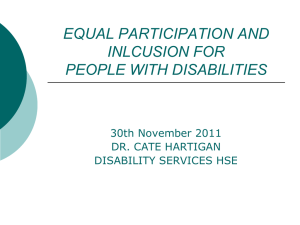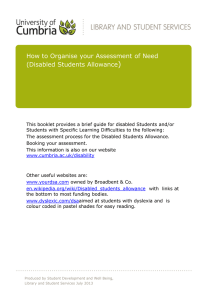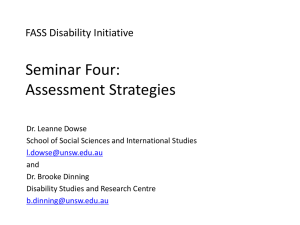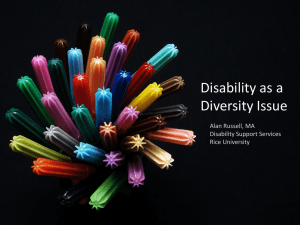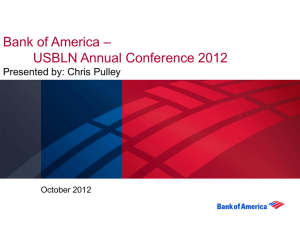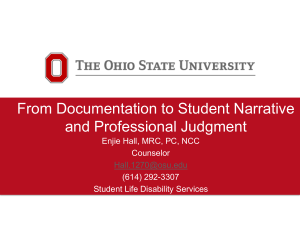Building Disability Confidence:What You Need to Know
advertisement
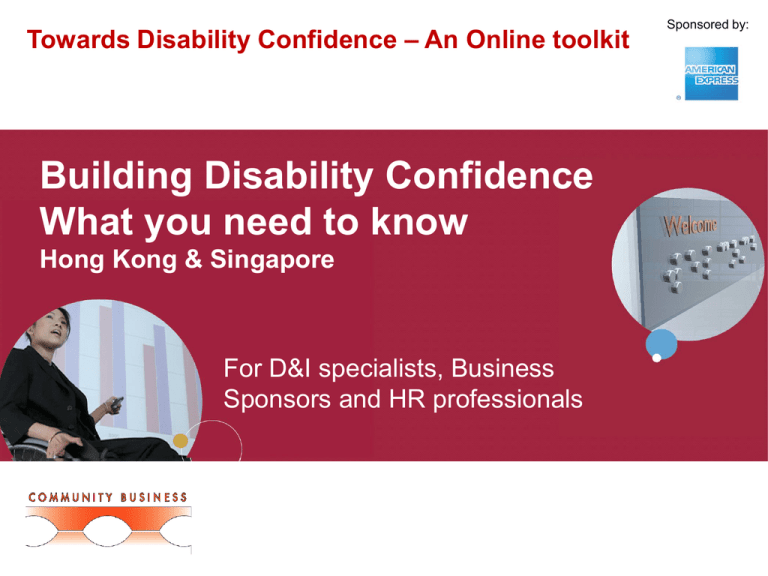
Towards Disability Confidence – An Online toolkit Building Disability Confidence What you need to know Hong Kong & Singapore For D&I specialists, Business Sponsors and HR professionals Sponsored by: Sponsored by: Introduction This Powerpoint presentation has been designed for the D&I specialist, senior leadership champion or HR professional, to give you the information you need to start making the business case for focusing on disabilty confidence in your organisation. • There are speaker notes for each slide in the Notes section visible via the Notes Page view. • The document has be created to be accessible to screen readers. This document can be used in conjunction with • ‘Towards Disability Confidence – A Resource Guide’ which gives more indepth details and case studies into the aspects of Disability in the workplace. The Resource Guide has been developed by Community Business, sponsored by American Express and & other organisation. • The other resources in the Disabilty Confidence Online Toolkit which provides simple tools and checklists for creating a Disability Strategy and for making your organisation more accessible to people with disabilities. 2 Sponsored by: Towards Disability Confidence – An Online toolkit ADDRESSING DISABILITY – A BUSINESS IMPERATIVE 3 Sponsored by: Disability in the Workplace – a few facts A person may have a physical, sensory or learning impairment, but it is often other people’s attitudes and a lack of accessibility of buildings, transport and information that disables people. • There are at least 650 million disabled people worldwide. • 400 million people with disabilities (PwDs) live in and around the Asia Pacific region. • 25% of the entire global population is either directly or indirectly affected by disability and impairment. • International studies suggest 1 in 3 people are disabled or close to someone who is. • The majority of disabled people are not born with a disability – 78% of people acquire their impairment aged 16 or over. 4 Sponsored by: A Broader Perspective of Disability Non-Visible Disabilities • Impairments such as epilepsy, dyslexia and diabetes affect huge numbers of people, but are rarely visible unless openly disclosed by the individual. Impact of Ageing Population • 78% of disabilities are acquired at the age of sixteen or over • 1 in 3 of those aged 50-64 have a disability • 33.6% of the population in Hong Kong and 36% of the population in Singapore will be over the age of 60 by 2030 People who Care for Dependents who Have a Disability Disability affects not only the individuals concerned. It also affects their family members and others who care for them. 5 Sponsored by: Key Issues for People with Disabilities General Challenges • • • • Social attitudes and ‘disability labels’ Barriers in education Low employment rate of people with disabilities Physical barriers Workplace Challenges • • • • • • Attitude of employers Limited experience or contact with disabled people Negative perceptions and false assumptions Uncertainty and fear Access to information Pressure to excel 6 Sponsored by: Beyond Legal Compliance Legal Compliance • In many countries growing legal obligations to: • Protect from discrimination • Ensure equal access to products and services Strategic Approach • Only when take a strategic approach and demonstrate commitment to best practice that can gain true business advantage 7 Sponsored by: Building a Disability Confident Organisation • For some years, people have talked about “mainstreaming disability” • Employers’ Forum on Disability (EFD) talks about “Disability Confidence”. A disability confident organisation: • Understands and adapts for how disability affects every aspect of the business – people, markets, communities, suppliers and key stakeholders. • Creates a culture of inclusion and removes barriers for groups of disabled people. • Makes adjustments which enable specific individuals to contribute – as employees, customers, partners and valued stakeholders 8 Sponsored by: Business Drivers for Disability Confidence A company which realises the potential of disabled employees will: A company which values disabled customers will: • Tap into a wider talent pool. • Improve recruitment practice by focusing on ability and potential. • Enable all to contribute by creating barrierfree working environments. • Enhance productivity by providing the right tools and training. • Harness diversity of thought and innovation as disabled employees bring different perspectives and problem solving techniques to the table. • Improve employee morale and engagement as people realise they themselves would be treated fairly should they become disabled. • Improve employee retention. • Reduce costs of sickness absence. • Reach a wider market. • Develop better designed, user-centred products and services. • Create innovative new products to meet their needs. • Provide clear and accessible communications which are easier for everyone to read and understand. • Deliver tailored services – and ultimately better services for everyone. • Stimulate demand from underserved customers. • Reduce loss of business from disabled customers who cannot access a company’s products and services. • Improve customer retention. • Enhance reputation with every customer. 9 Sponsored by: Towards Disability Confidence – An Online toolkit THE LOCAL CONTEXT HONG KONG & SINGAPORE 10 Sponsored by: The Legal Context • Hong Kong: Disability Discrimination Ordinance (DDO) • Singapore: Set up Tripartite Alliance for Fair Employment Practices (TAFEP) • UN Convention on Rights of Persons with Disabilities • Protect the rights and dignity of persons with disabilities. • Raise awareness for the need to counter discrimination caused by inaccessible technology 11 Sponsored by: Defining Disability in Hong Kong • In Hong Kong, Disability is defined by the DDO as: “…total or partial loss of a person’s bodily or mental functions, total or partical loss of a part of the body, the presence of organisms causing disease or illness (such as HIV), the malfunction, malformation or disfigurement of a part of the person’s body, or a disorder, illness or disease that affects a person’s perception of reality, emotions or judgement or that results in disturbed behaviour, and learning difficulties. A disability includes no only a disability which presently exists, but also a disability which previously existed but no longer exitsis, which may exist in the future or which is imputed to a person”. 12 Sponsored by: Defining Disability in Singapore • In Singapore, Disability is defined as: “those whose prospects of securing, retaining places and advancing in education and training institutions, employment and recreation as equal members of the community are substantially reduced as a result of physical, sensory, intellectual and developmental impairments”. Enabling Masterplan (2006) 13 Sponsored by: Cultural Context Both Singapore and Hong Kong have majority Chinese populations (77% and 95% respectively). Traditional attitudes towards disability shaped by: • mixture of religious beliefs and cultural values – influenced by Confucianism and Buddhism • folk religion Retribution of Sins Family Shame and Rejection Chinese Terminology Disability has traditionally been viewed in much of Asia ‘as a punishment for the disabled person's parental or past– life sins’. Responsibility to make the family proud – failures will cause embarrassment, shame, and loss of face to the entire family. The traditional Chinese terms for disability are "canfei (殘廢)," meaning "handicap" and "useless," or "canji," meaning "handicap" and "illness." 14 Sponsored by: Government Measures Hong Kong Singapore Plan: Rehabilitation Program Plan (RRP) Plan: Enabling Masterplan Steering Committee Promoting Employment: Selective Placement under the Labour Department and Work Orientation andPlacement Scheme Promoting Employment: Bizlink Centre – assessment and job placement service Employment Quotas: Nil Employment Quotas: Nil 15 Sponsored by: Towards Disability Confidence – An Online toolkit Towards Disability Confidence Recommendations for Employers Toolkit resources to support each recommendation are listed in the Notes view of slides 18-21 16 Sponsored by: Recommendations for Employers 17 Sponsored by: 1. Taking a Strategic Approach • • • • Establish the business case Identify a vision and goals Develop action plans – across all departments Build management commitment and leadership • ‘Promoting Disability Equality’ Guide clearly articulates vision • Provides 7 objectives for mainstreaming disability within the organisation • Describes what employees can do 18 2. Change Organisational Culture and Behaviour Sponsored by: • Provide disability awareness training • Bring senior executives and employees in contact with people with disabilities • Make management accountable • Runs a number of programmes in its offices across Asia to raise awareness and educate about disability • eLearning, Acting on Disability, Dialogue in the Dark • Introduced a region-wide Disability Panel Discussion with employees with disabilities sharing their personal experiences 19 3. Realise Potential of Disabled Employees • • • • • Sponsored by: Develop an equal opportunities policy Take proactive steps to recruit disabled employees Conduct an accessibility audit Make reasonable adjustments Offer training and development to disabled employees • Partnered with Delta Senior School to develop a curriculum to train students in hotel house- keeping • Complete training on site at hotel for 6 months • 40 students trained since programme set up, and many have taken on long-term employment at the hotel • Also pioneering Singapore’s first Centres for Training and Integration – aimed at enhancing employability 20 Sponsored by: 4. Value Disabled Customers • Ensure company is accessible • Communicate appropriately with disabled customers • Design products and services with disabled people in mind • Dedicated to providing ‘inclusive tourism’ • Guide Book for Guests with Disabilities • Nearly all attractions are accessible • Designated viewing areas • Tactile maps, audio and braille guides • Sign language interpretation at live theme park shows, eg “Festival of the Lion King” 21 Sponsored by: Towards Disability Confidence – An Online toolkit Conclusion 22 Sponsored by: A Significant Shift is Needed • Both Singapore and Hong Kong are making progress • growing awareness of the need to enable people with disabilities to contribute on a more equal basis • governments are taking commendable steps • Challenge and opportunity is for companies to engage on this subject • What is required is a significant shift in the way we view disability: • from corporate philanthropic gesture to a strategic business issue • Need to see the building of disability confidence 23 Sponsored by: It is a Business Imperative For this shift to occur, companies need to: • Understand the business case for realising the potential of disabled employees and valuing disabled customers • Take steps to remove barriers and make reasonable adjustments to enable people with disabilities to maximise their contribution – both as employees and customers The benefits: • In inclusive environments and cultures all benefit • Organisational reputation and brand are positively impacted and brand risk is reduced • Increased business results from the disabled customer segment 24 Sponsored by: For Further Information • Please contact Community Business at info@communitybusiness.org • You can access the Towards Disability Confidence – A Resource Guide and the Online Toolkit at www.communitybusiness.org 25

